Mikawa Zezankyo (Tokyo, Japan)
Tempura Mikawa Zezankyo
1-3-1 Fukuzumi, Koto-ku, Tokyo 135-0032
03.3643.8383
mikawa-zezankyo.jimdo.com
Sun 10/27/2019, 07:40p-09:10p

I often bemoan the lack of tempura specialist spots here in the US, which I imagine is due to the lack of respect most Americans have for it (I think it's viewed as a cheap sort of food here in the States). Given that, I made it a point to visit such a place during my time in Japan, and ended up here at Tetsuya Saotome's Mikawa Zezankyo. The restaurant bills itself as an edomae-style tempura joint, which ostensibly means it primarily focuses on serving the style of tempura available in the Tokyo area during the Edo period.
About the Chef: Sometimes referred to as the "god of tempura," shokunin Saotome Tetsuya was born in 1947 in the Nagoya area, and in fact, the restaurant is supposedly named after Mikawa Province, an old administrative division that encompassed his hometown. He initially wanted to pursue a career in sushi, but after being convinced otherwise by tempura chef Syotaro Uemura, he began training under him at the age of 15. After learning for 14 years, Saotome-san was finally ready to strike out on his own, and opened Tempura Mikawa Kayabacho in Tokyo's Nihonbashi neighborhood in April 1976, when he was 29. The place had a steady following, and its success allowed the Chef to launch his second restaurant, Tempura Mikawa Roppongi Hills Keyakizaka, in 2003, with his former second-in-command running the show.
Mikawa Zezankyo, meanwhile, debuted in April 2009 (I think he handed off the original eatery to his son), situated on a site near the Sumida River that he purchased circa 1982. The current building was reportedly constructed around 1997, and features five levels. The first holds the bulk of the restaurant, while the second and third floors are home to private dining rooms and art exhibition spaces; I've heard that Saotome actually lives on the higher floors. Zezankyo was largely well-received, and even landed a Michelin star in 2010, but evidently lost in back in 2015. An interesting note: the Chef is a friend of Jiro Ono (of Sukiyabashi Jiro Honten fame), and apparently made an appearance in David Gelb's seminal film Jiro Dreams of Sushi.
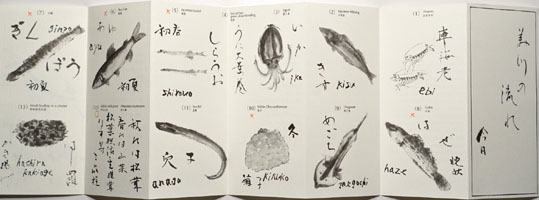
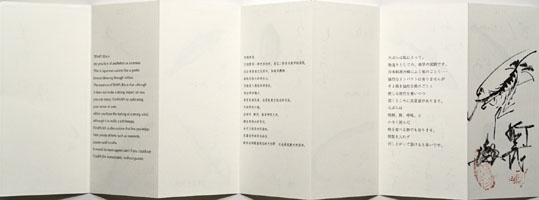
Above we see what sort of amounts to a menu, replete with Saotome's rather striking calligraphy/prawn drawing/stamp on the front cover (I asked for his signature at the end of the meal). As for the cost, we were charged ¥19,000 ($174.85) a head, plus 10% sales tax; there was also a ¥10,000 ($92.03) per person deposit required, which was of course applied to the bill. Click for larger versions.

1: Sakizuke San-ten-mori
The meal kicked off with a trio of small bites, already on the counter when we arrived. On the left was a small mound of zesty greens dusted with a nutty topping; I'm guessing this was mitsuba with some sort of sesame seed. This was followed by a dollop of super creamy tofu finished with what I believe was a miso-based condiment. Last up was what seemed like an aspic comprising fish (eel perhaps?) encased in gelatin.
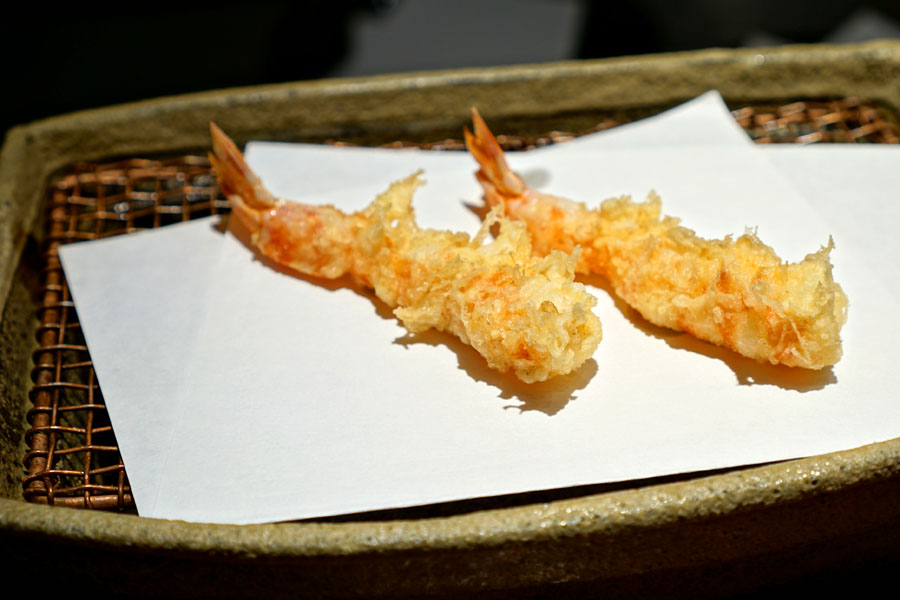
2: Kuruma Ebi
Our parade of tempura began with Japanese tiger prawn. These were spot on texturally, and I loved their combination of softness and snap, while the cook on 'em was just the slightest bit rare. At the same time, their subtle sweetness made for a great contrast with the robust batter. A strong start.
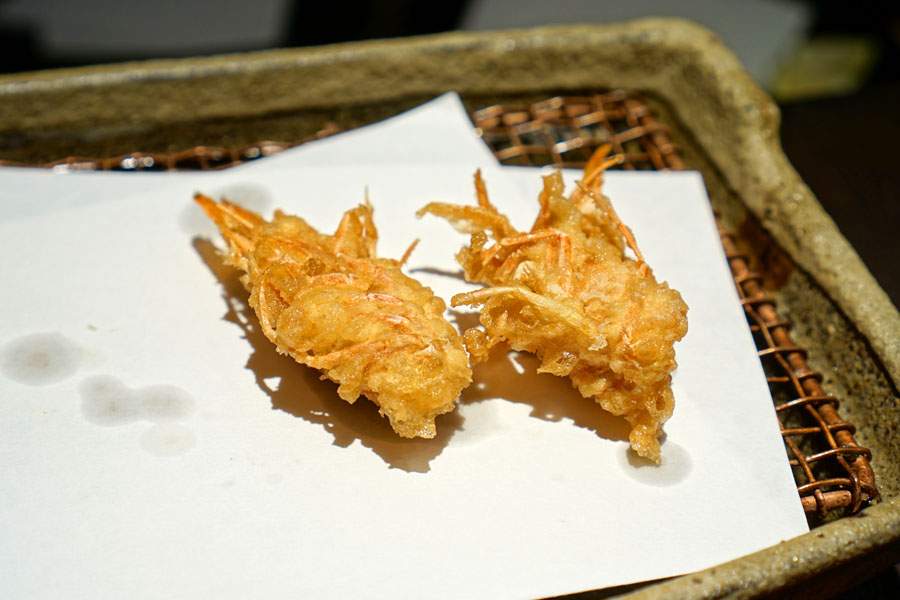
3: Ebi no Atama
The shrimp heads were subsequently served, and might've been even better than the bodies thanks to their excellent crunch and brine, tempered just a smidge by the application of tentsuyu.
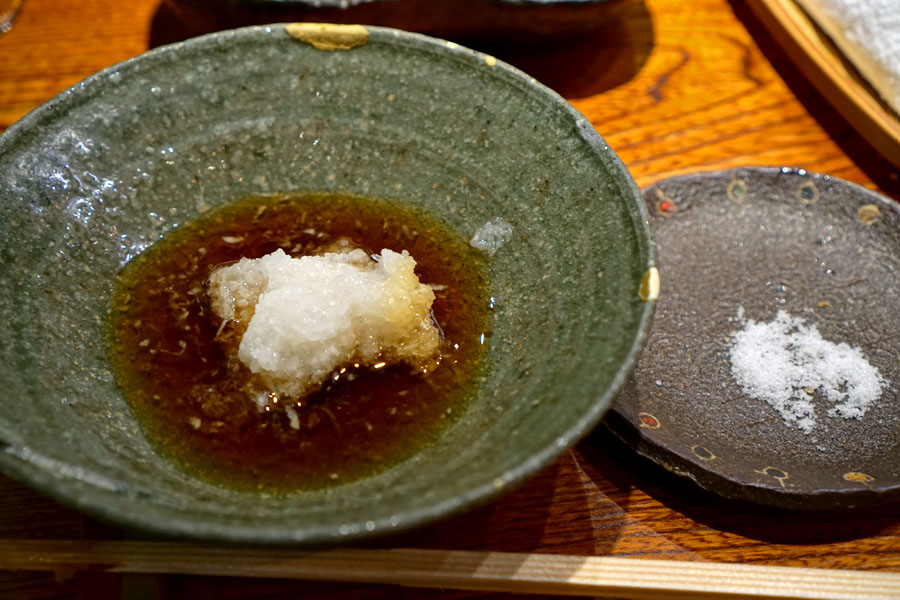
And speaking of tentsuyu, here we see it, replete with a mound of daikon oroshi and salt on the side.
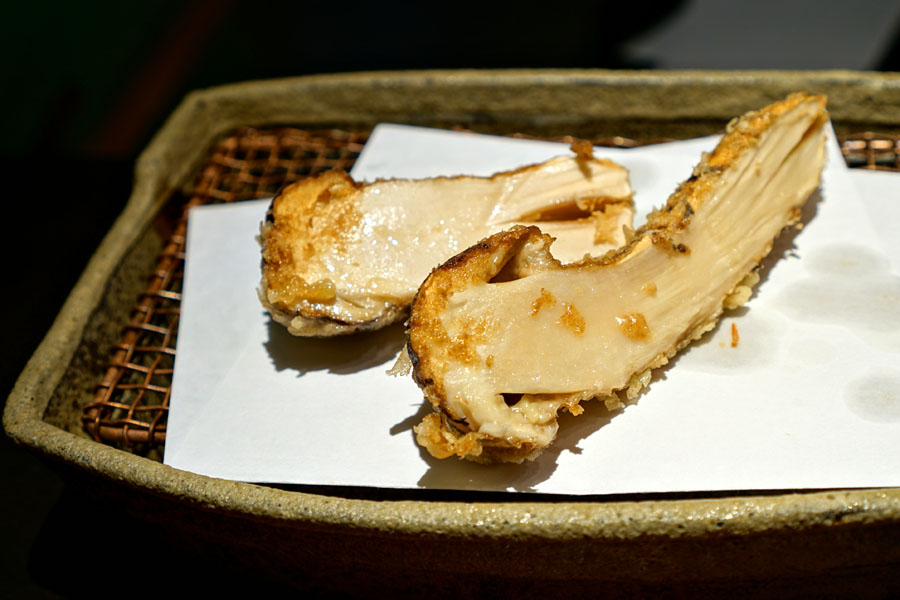
4: Matsutake
We were in peak matsutake season, so it wasn't a surprise to see them here. The mushrooms had a decidedly meaty, fibrous consistency, along with a prodigiously woodsy funk that was duly contrasted by hits of shio and sudachi.
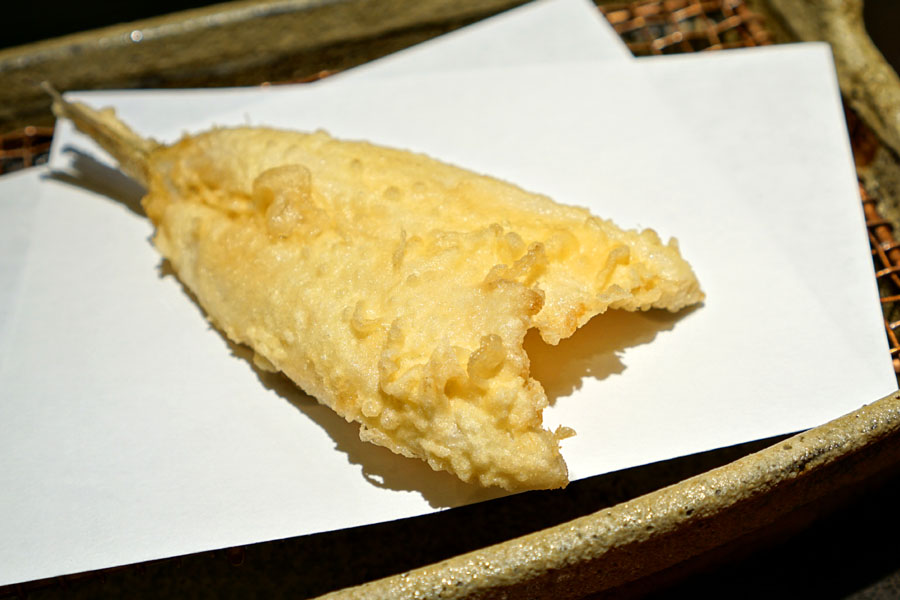
5: Kisu
Japanese whiting was super delicate, super finessed, and absolutely wonderful with just the slightest pinch of salt. I'd say that this was probably the best preparation of fish tempura I've had.
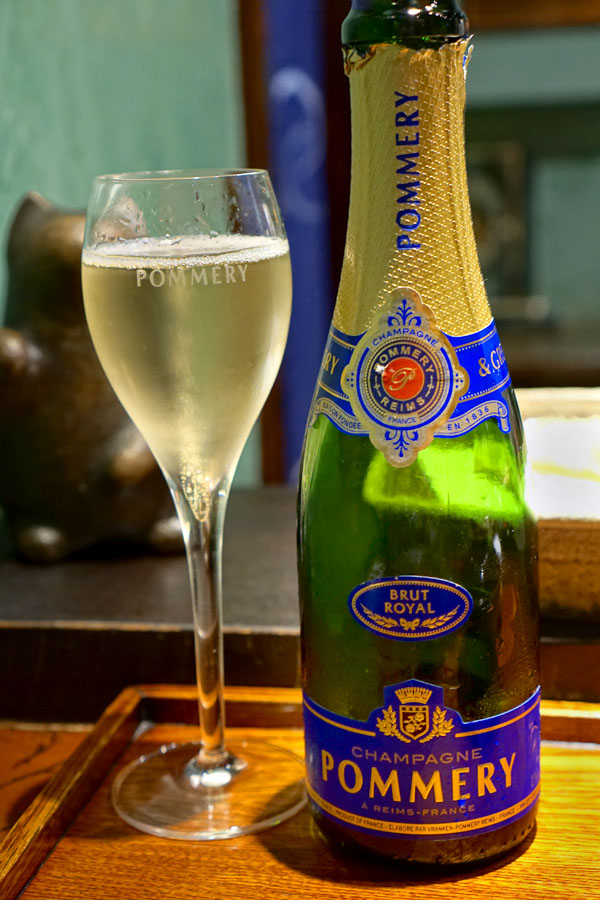
Bubbly usually pairs well with fried foods, so beverage-wise I went with a half-bottle of the NV Pommery Champagne Brut Royal [¥4,500 ($41.41)]. I found it well balanced, bringing forth stone fruit, citrus, nuts, toast, and oxidation in all the right quantities. The wine really did stand up to the tempura beautifully.

6: Ika
I believe this was sumi-ika, or ink squid. Whatever it was, it had an utterly satisfying texture that was simultaneously supple and substantial, and which paired swimmingly with the crispy batter going on. Meanwhile, flavors were a touch briny, a touch sweet, and certainly enhanced by the application of salt, which highlighted the inherent salinity of the squid.
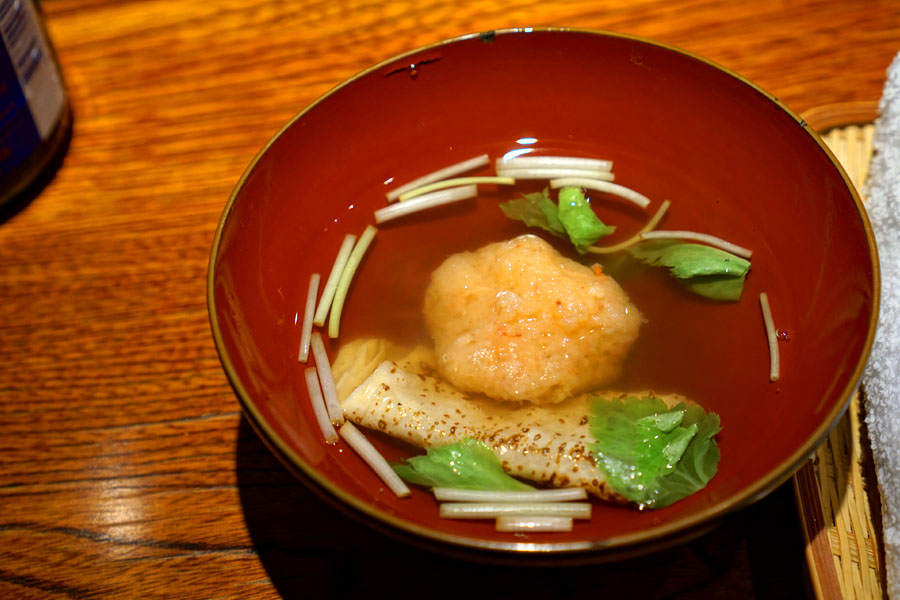
7: Suimono
A clear soup showed off vibrant, focused flavors along with a great herbaceousness. Floating in the broth was a sweet ebi-shinjo dumpling and a fantastically-textured "crêpe" that I think was made of yuba. A welcomed respite from all the tempura.
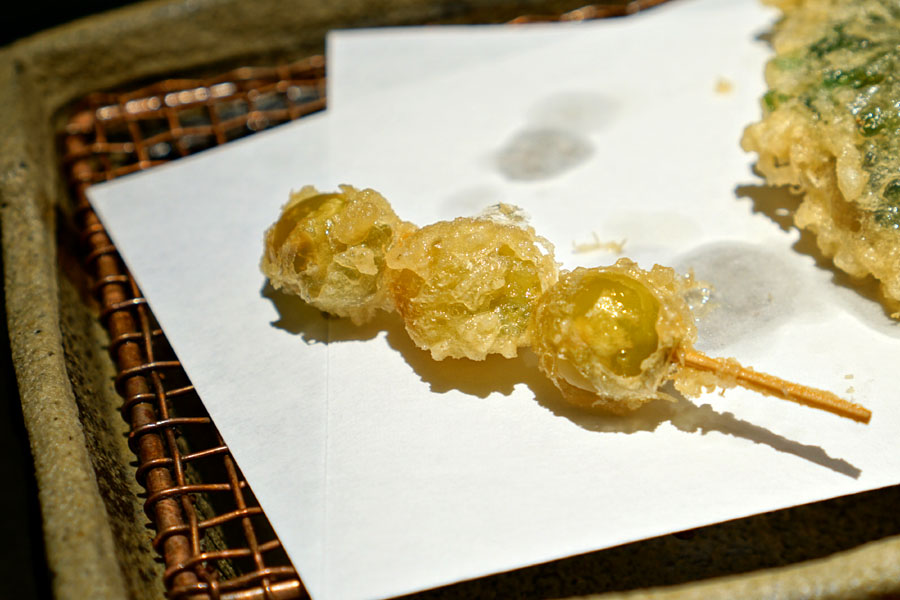
8: Ginnan
Ginkgo nuts were crispy on the outside, but chewy on the inside, and had a slight bitterness to them that linked up nicely with a pinch of salt.
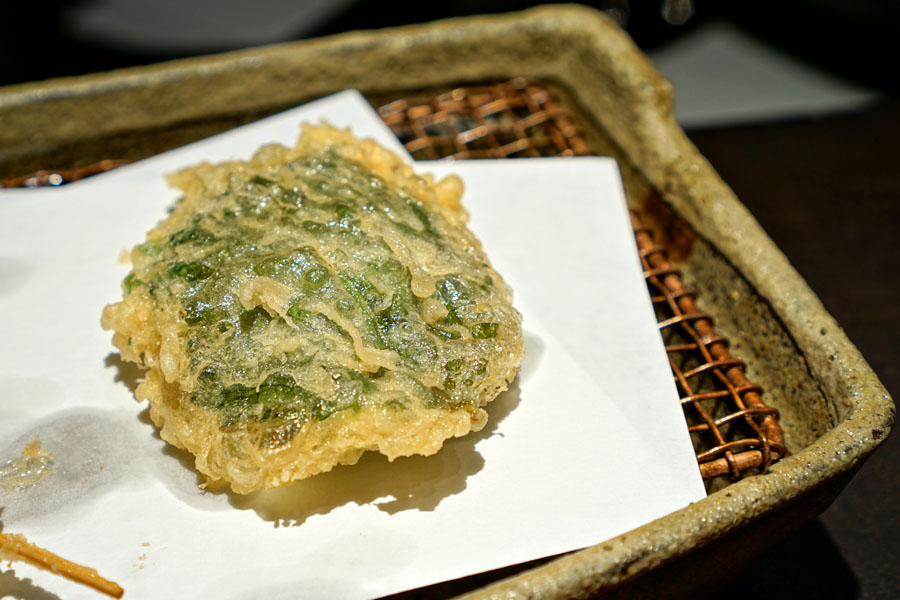

9: Uni Dai Hamaki
Next was what the Chef describes as a "cigar," one comprising lush, creamy, almost sugary sea urchin set in a minty shiso wrapper. A neat contrast.

10: Megochi
Big-eyed flathead had some surprisingly concentrated flavors that nonetheless represented an exercise in both subtlety and profundity.
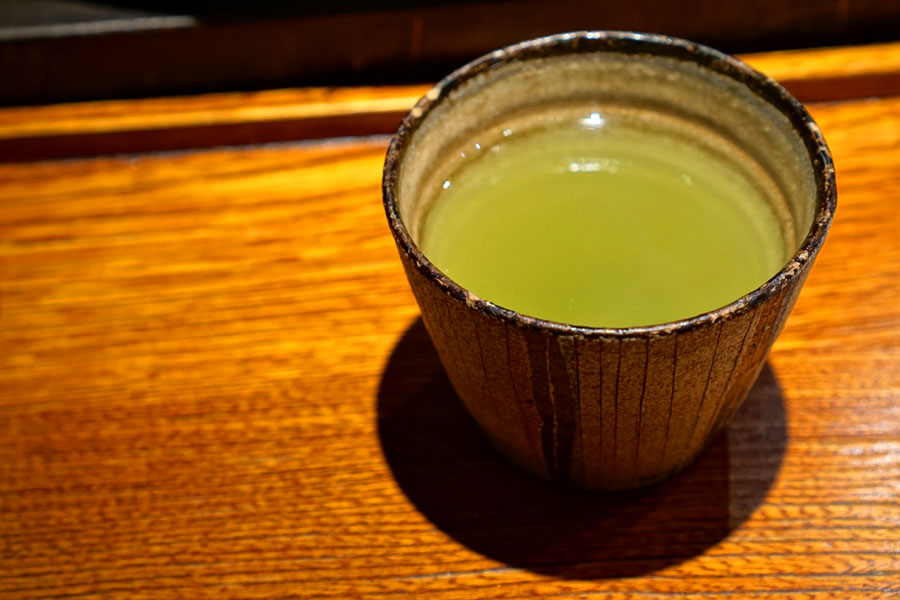
Green tea did a respectable job taking over from the Champagne.

11: Anago
Next came the conger eel, which is arguably Saotome-san's signature dish. It arrived as an impressively large specimen (the single largest piece of tempura I've ever had), cut in half in one seamless motion by the Chef's chopsticks. I found it particularly crispy, but with soft, moist insides and a forceful brine. What was interesting was that some parts of the fish were noticeably more saline than others (I think getting near the tail end), so a dip in tentsuyu was key for moderation.
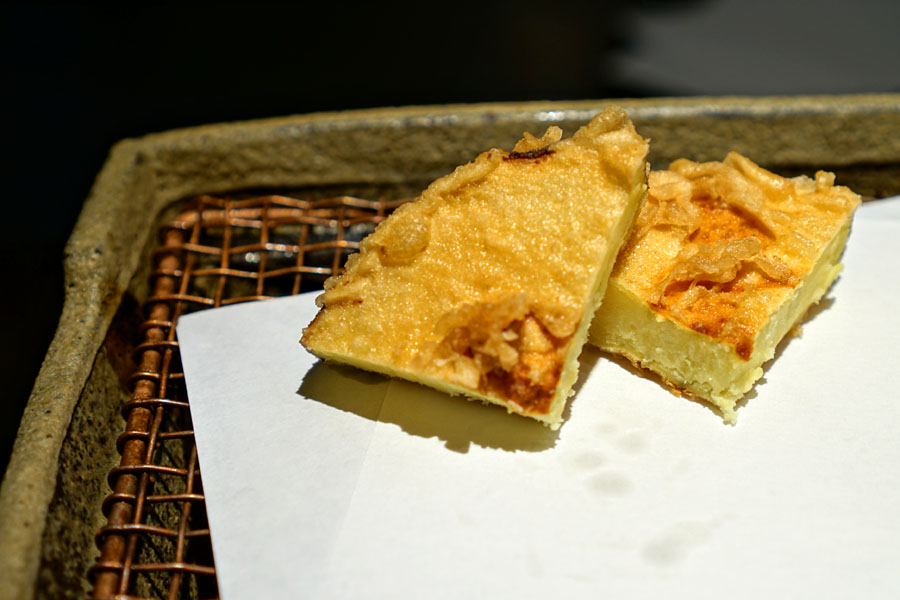
12: Satsumaimo
At this point, we arrived at the vegetable portion of our meal, and we even got to choose our own veggies. Up first was sweet potato, which fortunately wasn't overly sweet, and had a firm-ish, almost gritty texture that I rather liked.

13: Asupara
Asparagus was juicy and bittersweet, with an especially delicate battering to boot.
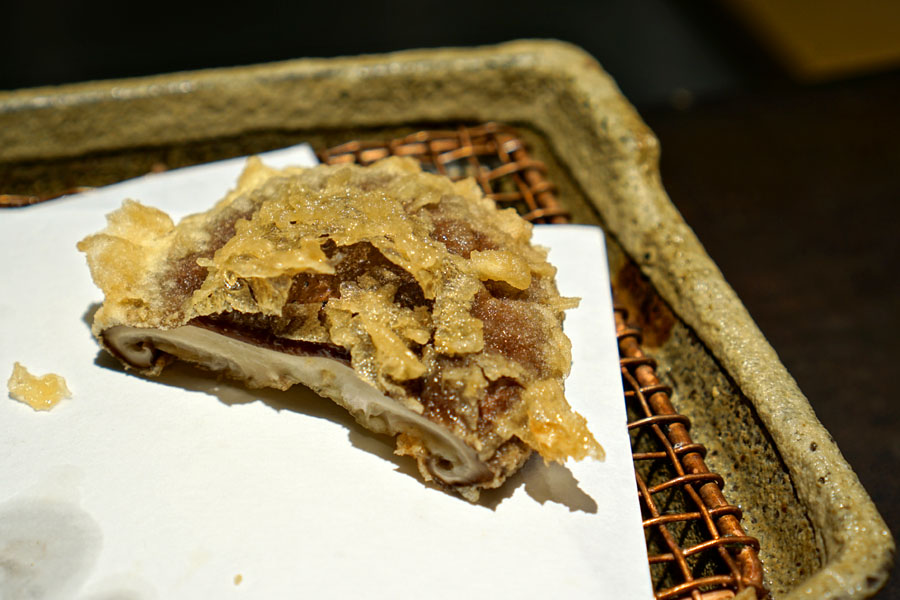
14: Shiitake
Shiitake mushroom had a wonderful textural contrast between supple and springy, while its classic umami flavors satisfied as always.
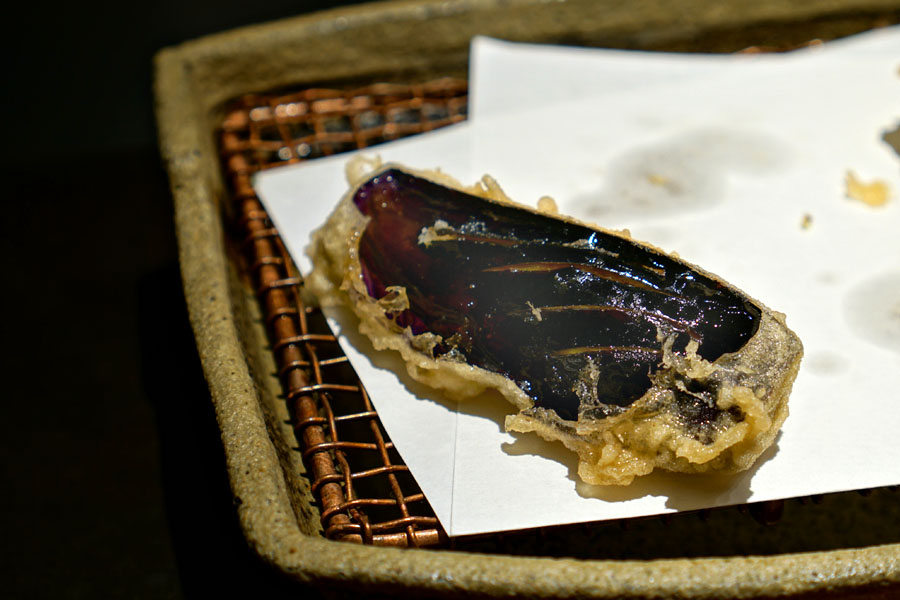
15: Nasu
Eggplant was soft and spongy, but still had a good chew to it, while flavors were surprisingly briny.
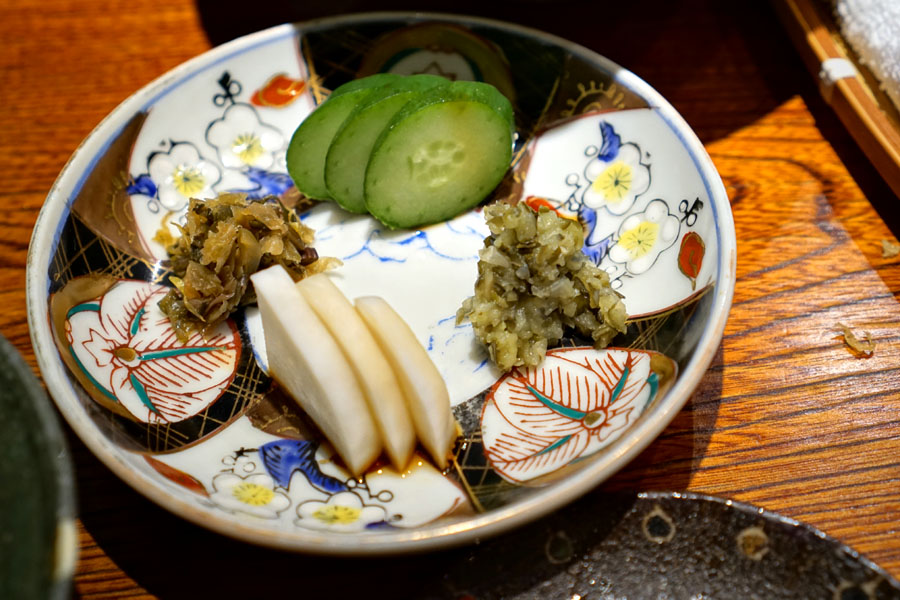

16: Tempura Chazuke
We closed things out with the shokuji portion of our dinner. We were given a choice between tendon and tencha, and I obviously went with the latter. The hashira kakiage served as a fitting, satisfying finish to the meal, especially when taken with rice and the heat of wasabi. Also crucial were the konomono (pickles), which included bitter daikon, cucumber two ways, and my favorite: the zesty suancai-like bangiku.
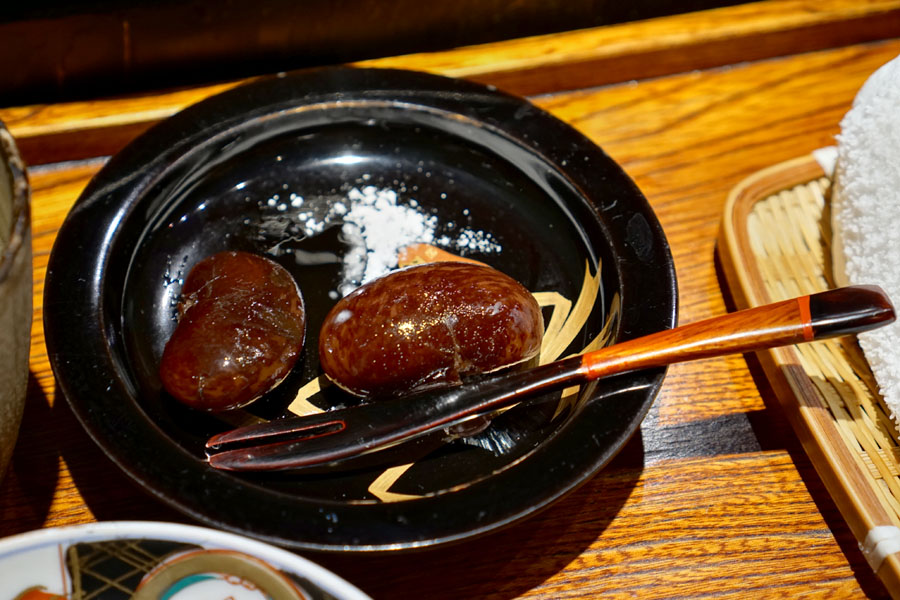
17: Hanamame
Dessert was composed of some disconcertingly large hana-mame (flower beans), which were sugary, nutty, and much better than I expected.
I made it a point to get tempura on this trip, and I'm glad to report that the tempura here was right up there with the best I've had. Saotome's batter is pretty pronounced I'd say, but at the same time elegant, and you certainly don't lose sight of the main ingredient. It's a fine balance--seemingly simple, maybe even a bit old school, yet uncompromisingly precise. They say that the beauty of tempura lies in appreciating subtleties, and I think you get that here.
1-3-1 Fukuzumi, Koto-ku, Tokyo 135-0032
03.3643.8383
mikawa-zezankyo.jimdo.com
Sun 10/27/2019, 07:40p-09:10p

I often bemoan the lack of tempura specialist spots here in the US, which I imagine is due to the lack of respect most Americans have for it (I think it's viewed as a cheap sort of food here in the States). Given that, I made it a point to visit such a place during my time in Japan, and ended up here at Tetsuya Saotome's Mikawa Zezankyo. The restaurant bills itself as an edomae-style tempura joint, which ostensibly means it primarily focuses on serving the style of tempura available in the Tokyo area during the Edo period.
About the Chef: Sometimes referred to as the "god of tempura," shokunin Saotome Tetsuya was born in 1947 in the Nagoya area, and in fact, the restaurant is supposedly named after Mikawa Province, an old administrative division that encompassed his hometown. He initially wanted to pursue a career in sushi, but after being convinced otherwise by tempura chef Syotaro Uemura, he began training under him at the age of 15. After learning for 14 years, Saotome-san was finally ready to strike out on his own, and opened Tempura Mikawa Kayabacho in Tokyo's Nihonbashi neighborhood in April 1976, when he was 29. The place had a steady following, and its success allowed the Chef to launch his second restaurant, Tempura Mikawa Roppongi Hills Keyakizaka, in 2003, with his former second-in-command running the show.
Mikawa Zezankyo, meanwhile, debuted in April 2009 (I think he handed off the original eatery to his son), situated on a site near the Sumida River that he purchased circa 1982. The current building was reportedly constructed around 1997, and features five levels. The first holds the bulk of the restaurant, while the second and third floors are home to private dining rooms and art exhibition spaces; I've heard that Saotome actually lives on the higher floors. Zezankyo was largely well-received, and even landed a Michelin star in 2010, but evidently lost in back in 2015. An interesting note: the Chef is a friend of Jiro Ono (of Sukiyabashi Jiro Honten fame), and apparently made an appearance in David Gelb's seminal film Jiro Dreams of Sushi.


Above we see what sort of amounts to a menu, replete with Saotome's rather striking calligraphy/prawn drawing/stamp on the front cover (I asked for his signature at the end of the meal). As for the cost, we were charged ¥19,000 ($174.85) a head, plus 10% sales tax; there was also a ¥10,000 ($92.03) per person deposit required, which was of course applied to the bill. Click for larger versions.

1: Sakizuke San-ten-mori
The meal kicked off with a trio of small bites, already on the counter when we arrived. On the left was a small mound of zesty greens dusted with a nutty topping; I'm guessing this was mitsuba with some sort of sesame seed. This was followed by a dollop of super creamy tofu finished with what I believe was a miso-based condiment. Last up was what seemed like an aspic comprising fish (eel perhaps?) encased in gelatin.

2: Kuruma Ebi
Our parade of tempura began with Japanese tiger prawn. These were spot on texturally, and I loved their combination of softness and snap, while the cook on 'em was just the slightest bit rare. At the same time, their subtle sweetness made for a great contrast with the robust batter. A strong start.

3: Ebi no Atama
The shrimp heads were subsequently served, and might've been even better than the bodies thanks to their excellent crunch and brine, tempered just a smidge by the application of tentsuyu.

And speaking of tentsuyu, here we see it, replete with a mound of daikon oroshi and salt on the side.

4: Matsutake
We were in peak matsutake season, so it wasn't a surprise to see them here. The mushrooms had a decidedly meaty, fibrous consistency, along with a prodigiously woodsy funk that was duly contrasted by hits of shio and sudachi.

5: Kisu
Japanese whiting was super delicate, super finessed, and absolutely wonderful with just the slightest pinch of salt. I'd say that this was probably the best preparation of fish tempura I've had.

Bubbly usually pairs well with fried foods, so beverage-wise I went with a half-bottle of the NV Pommery Champagne Brut Royal [¥4,500 ($41.41)]. I found it well balanced, bringing forth stone fruit, citrus, nuts, toast, and oxidation in all the right quantities. The wine really did stand up to the tempura beautifully.

6: Ika
I believe this was sumi-ika, or ink squid. Whatever it was, it had an utterly satisfying texture that was simultaneously supple and substantial, and which paired swimmingly with the crispy batter going on. Meanwhile, flavors were a touch briny, a touch sweet, and certainly enhanced by the application of salt, which highlighted the inherent salinity of the squid.

7: Suimono
A clear soup showed off vibrant, focused flavors along with a great herbaceousness. Floating in the broth was a sweet ebi-shinjo dumpling and a fantastically-textured "crêpe" that I think was made of yuba. A welcomed respite from all the tempura.

8: Ginnan
Ginkgo nuts were crispy on the outside, but chewy on the inside, and had a slight bitterness to them that linked up nicely with a pinch of salt.


9: Uni Dai Hamaki
Next was what the Chef describes as a "cigar," one comprising lush, creamy, almost sugary sea urchin set in a minty shiso wrapper. A neat contrast.

10: Megochi
Big-eyed flathead had some surprisingly concentrated flavors that nonetheless represented an exercise in both subtlety and profundity.

Green tea did a respectable job taking over from the Champagne.

11: Anago
Next came the conger eel, which is arguably Saotome-san's signature dish. It arrived as an impressively large specimen (the single largest piece of tempura I've ever had), cut in half in one seamless motion by the Chef's chopsticks. I found it particularly crispy, but with soft, moist insides and a forceful brine. What was interesting was that some parts of the fish were noticeably more saline than others (I think getting near the tail end), so a dip in tentsuyu was key for moderation.

12: Satsumaimo
At this point, we arrived at the vegetable portion of our meal, and we even got to choose our own veggies. Up first was sweet potato, which fortunately wasn't overly sweet, and had a firm-ish, almost gritty texture that I rather liked.

13: Asupara
Asparagus was juicy and bittersweet, with an especially delicate battering to boot.

14: Shiitake
Shiitake mushroom had a wonderful textural contrast between supple and springy, while its classic umami flavors satisfied as always.

15: Nasu
Eggplant was soft and spongy, but still had a good chew to it, while flavors were surprisingly briny.


16: Tempura Chazuke
We closed things out with the shokuji portion of our dinner. We were given a choice between tendon and tencha, and I obviously went with the latter. The hashira kakiage served as a fitting, satisfying finish to the meal, especially when taken with rice and the heat of wasabi. Also crucial were the konomono (pickles), which included bitter daikon, cucumber two ways, and my favorite: the zesty suancai-like bangiku.

17: Hanamame
Dessert was composed of some disconcertingly large hana-mame (flower beans), which were sugary, nutty, and much better than I expected.
I made it a point to get tempura on this trip, and I'm glad to report that the tempura here was right up there with the best I've had. Saotome's batter is pretty pronounced I'd say, but at the same time elegant, and you certainly don't lose sight of the main ingredient. It's a fine balance--seemingly simple, maybe even a bit old school, yet uncompromisingly precise. They say that the beauty of tempura lies in appreciating subtleties, and I think you get that here.
0 Comments:
Post a Comment
Subscribe to Post Comments [Atom]
<< Home